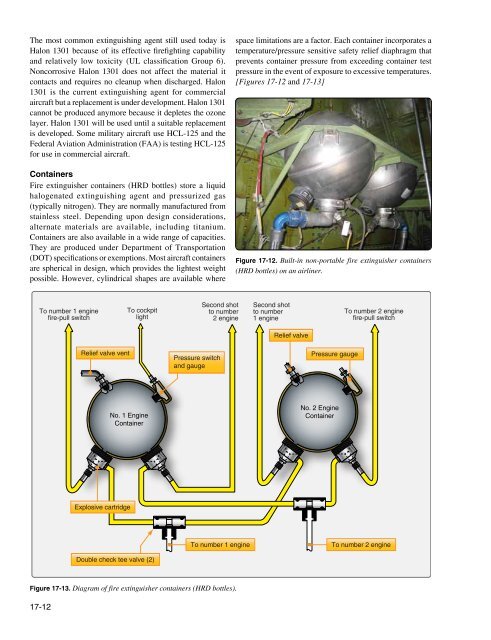ama_Ch17
ama_Ch17
ama_Ch17
You also want an ePaper? Increase the reach of your titles
YUMPU automatically turns print PDFs into web optimized ePapers that Google loves.
The most common extinguishing agent still used today is<br />
Halon 1301 because of its effective firefighting capability<br />
and relatively low toxicity (UL classification Group 6).<br />
Noncorrosive Halon 1301 does not affect the material it<br />
contacts and requires no cleanup when discharged. Halon<br />
1301 is the current extinguishing agent for commercial<br />
aircraft but a replacement is under development. Halon 1301<br />
cannot be produced anymore because it depletes the ozone<br />
layer. Halon 1301 will be used until a suitable replacement<br />
is developed. Some military aircraft use HCL-125 and the<br />
Federal Aviation Administration (FAA) is testing HCL-125<br />
for use in commercial aircraft.<br />
Containers<br />
Fire extinguisher containers (HRD bottles) store a liquid<br />
halogenated extinguishing agent and pressurized gas<br />
(typically nitrogen). They are normally manufactured from<br />
stainless steel. Depending upon design considerations,<br />
alternate materials are available, including titanium.<br />
Containers are also available in a wide range of capacities.<br />
They are produced under Department of Transportation<br />
(DOT) specifications or exemptions. Most aircraft containers<br />
are spherical in design, which provides the lightest weight<br />
possible. However, cylindrical shapes are available where<br />
space limitations are a factor. Each container incorporates a<br />
temperature/pressure sensitive safety relief diaphragm that<br />
prevents container pressure from exceeding container test<br />
pressure in the event of exposure to excessive temperatures.<br />
[Figures 17-12 and 17-13]<br />
Figure 17-12. Built-in non-portable fire extinguisher containers<br />
(HRD bottles) on an airliner.<br />
To number 1 engine<br />
fire-pull switch<br />
To cockpit<br />
light<br />
Second shot<br />
to number<br />
2 engine<br />
Second shot<br />
to number<br />
1 engine<br />
To number 2 engine<br />
fire-pull switch<br />
Relief valve<br />
Relief valve vent<br />
Pressure switch<br />
and gauge<br />
Pressure gauge<br />
No. 1 Engine<br />
Container<br />
No. 2 Engine<br />
Container<br />
Explosive cartridge<br />
Double check tee valve (2)<br />
To number 1 engine<br />
To number 2 engine<br />
Figure 17-13. Diagram of fire extinguisher containers (HRD bottles).<br />
17-12


